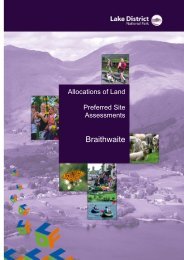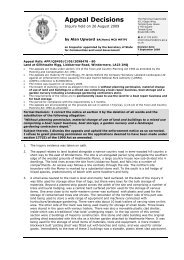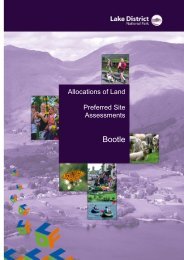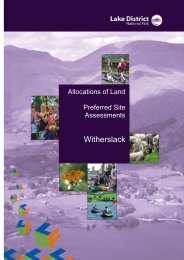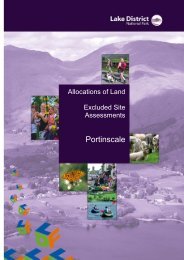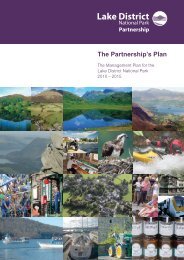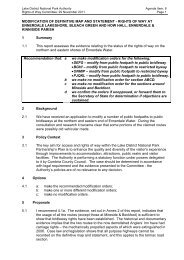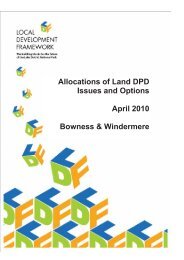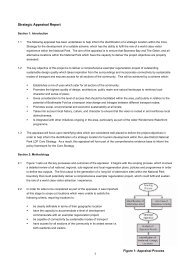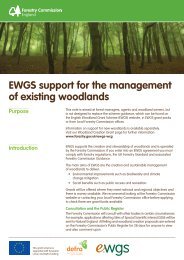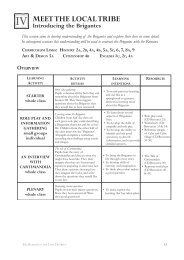Flood Risk Assessments - Lake District National Park
Flood Risk Assessments - Lake District National Park
Flood Risk Assessments - Lake District National Park
You also want an ePaper? Increase the reach of your titles
YUMPU automatically turns print PDFs into web optimized ePapers that Google loves.
<strong>Flood</strong> <strong>Risk</strong> <strong>Assessments</strong><br />
What do I submit with my Planning Application?<br />
www.lakedistrict.gov.uk<br />
May 2012
Introduction<br />
<strong>Flood</strong>ing from rivers and coastal waters is a natural process that plays an important role in shaping the natural environment.<br />
<strong>Flood</strong>ing can also threaten life and cause substantial damage to property. Although flooding cannot be<br />
entirely prevented, its impacts can be avoided and reduced through good planning and management.<br />
All forms of flooding and their impact on the natural and built environment are material planning considerations.<br />
The planning process looks to avoid inappropriate development in areas at risk of flooding, and to direct development<br />
away from areas at highest risk of flooding. Where new development is necessary in high risk areas, it must be<br />
made safe without increasing flood risk elsewhere and where possible, reducing flood risk overall.<br />
<strong>Flood</strong>ing should be considered as early as possible in preparing development proposals.<br />
When do I need to provide a flood risk assessment?<br />
Proposals for the following types of development must be accompanied by a flood risk assessment before we will<br />
validate the application:<br />
• development proposals of 1 hectare or greater in flood risk zone 1<br />
• any proposal in flood risk zone 2<br />
• any proposal in flood risk zone 3<br />
If you are planning development it is your responsibility to fully assess flood risk, propose measures to mitigate it and<br />
demonstrate that any residual risks can be safely managed. <strong>Flood</strong> resistance and resilience measures should not be used<br />
to justify development in inappropriate locations.<br />
What information should a flood risk assessment include?<br />
A site-specific flood risk assessment is carried out by, or on behalf of, a developer to assess the risk to a development<br />
site and demonstrate how flood risk from all sources of flooding to the development itself and flood risk to others<br />
will be managed now, and taking climate change into account.<br />
For small scale proposals (domestic extensions, or non-domestic extensions of less than 250sqm footprint) you can<br />
submit the simple table in Box 1 opposite to satisfy the requirement to provide a site specific flood risk assessment.<br />
All other applications for development in areas identified as being at potential risk of flooding must be accompanied<br />
by a site specific flood risk assessment developed in accordance with the requirements of the Technical Guidance<br />
to the <strong>National</strong> Planning Policy Framework, and taking into account Environment Agency standing advice. A<br />
site specific flood risk assessment should identify and assess the risks of all forms of flooding to and from the<br />
development and demonstrate how these flood risks will be managed so that the development remains safe<br />
throughout its lifetime, taking climate change into account. Developers should take advice from the emergency<br />
services when producing an evacuation plan for the development as part of the flood risk assessment.<br />
<strong>Flood</strong> risk assessments should:<br />
• be proportionate to the risk and appropriate to the scale, nature and location of the development;<br />
• consider the risk of flooding arising from the development in addition to the risk of flooding to the development;<br />
• take the impacts of climate change into account<br />
• be undertaken by competent people, as early as possible in the particular planning process, to avoid misplaced<br />
effort and raising landowner expectations where land is unsuitable for development;<br />
• consider both the potential adverse and beneficial effects of flood risk management infrastructure including<br />
raised defences, flow channels, flood storage areas and other artificial features together with the consequences<br />
of their failure;<br />
• consider the vulnerability of those that could occupy and use the development, taking account of the Sequential<br />
and Exception Tests and the vulnerability classification, including arrangements for safe access;<br />
www.lakedistrict.gov.uk
•<br />
•<br />
purpose of the decisions being made;<br />
historic environment and river and coastal processes;<br />
• include the assessment of the remaining (known as ‘residual’) risk after risk reduction measures have been taken<br />
into account and demonstrate that this is acceptable for the particular development or land use;<br />
• consider how the ability of water to soak into the ground may change with development, along with how the<br />
• be supported by appropriate data and information, including historical information on previous events.<br />
Box 1: Householder and other minor extensions in <strong>Flood</strong> <strong>Risk</strong> Zones 2 and 3<br />
If you are submitting a planning application for a householder development or a non-residential extension with a<br />
assessment your application will be invalid.<br />
Before completing the form below you should refer to the Environment Agency’s standing advice (see www.environment-agency.gov.uk).<br />
You must make it clear on your plans where the required mitigation measures have been incorporated into your scheme.<br />
To be completed by the applicant and submitted with the application...<br />
Complete the table below and include it with the planning application submission. We will use the table, together with<br />
the supporting evidence as the <strong>Flood</strong> <strong>Risk</strong> Assessment for your application.<br />
Applicant to choose one or other<br />
below<br />
Applicant to provide the LPA with<br />
the supporting Information detailed<br />
below as part of their FRA<br />
Applicant to indicate their choice<br />
in the box below. Enter ‘yes’ or ‘no’<br />
Either ;<br />
Floor levels within the proposed<br />
development will be set no lower<br />
-<br />
ment has been incorporated where<br />
appropriate.<br />
-<br />
silience and resistance techniques,<br />
to be included in accordance with<br />
of new buildings’ CLG (2007)<br />
Or;<br />
Floor levels within the extension will<br />
be set 300mm above the known or<br />
modelled 1 in 100 annual probabilithe<br />
<strong>Flood</strong> Zones.<br />
This must be demonstrated by a<br />
relative to the known or modelled<br />
All levels should be stated in relation<br />
to Ordnance Datum.<br />
www.lakedistrict.gov.uk
Useful reading<br />
• Department of Communities and Local Government (2012), <strong>National</strong> Planning Policy Framework.<br />
London, DCLG.<br />
• Department of Communities and Local Government (2012), Technical Guidance to the <strong>National</strong><br />
Planning Policy Framework. London, DCLG.<br />
• www.environment-agency.gov.uk<br />
Contact us<br />
<strong>Lake</strong> <strong>District</strong> <strong>National</strong> <strong>Park</strong> Authority<br />
Murley Moss Business <strong>Park</strong><br />
Oxenholme Road<br />
Kendal<br />
LA9 7RL<br />
Telephone: 01539 724555<br />
Fax: 01539 740822<br />
Minicom: 01539 792690<br />
Email: hq@lakedistrict.gov.uk<br />
www.lakedistrict.gov.uk<br />
A duty planning officer is available Monday<br />
to Friday between 9.30am and 12.30pm<br />
to talk to either by phone or in person at<br />
our Kendal offices. We also run planning<br />
surgeries in Keswick, Glenridding and<br />
Gosforth where you can meet an officer in<br />
person. Please see our website or call us for<br />
details of surgery times and locations.



